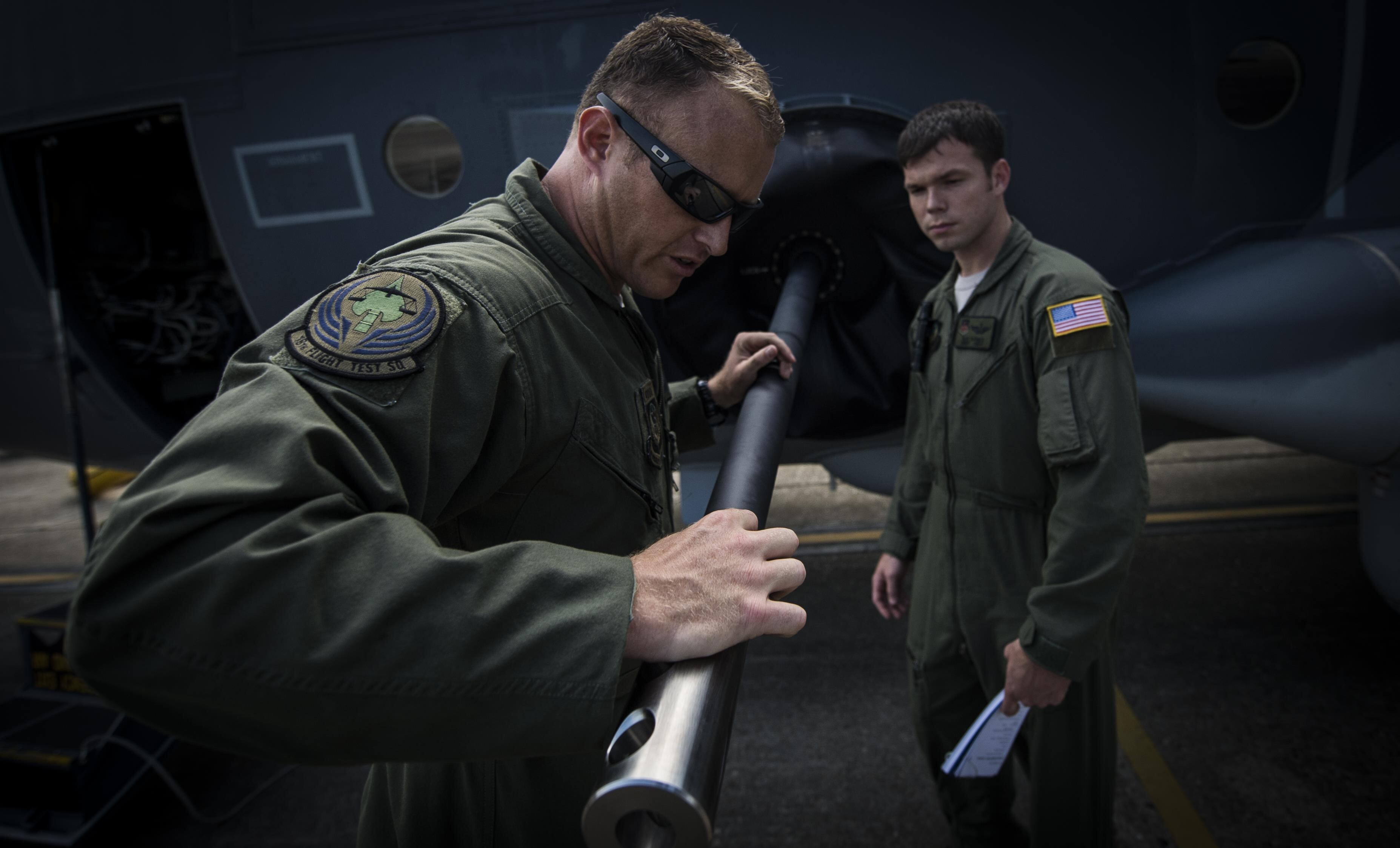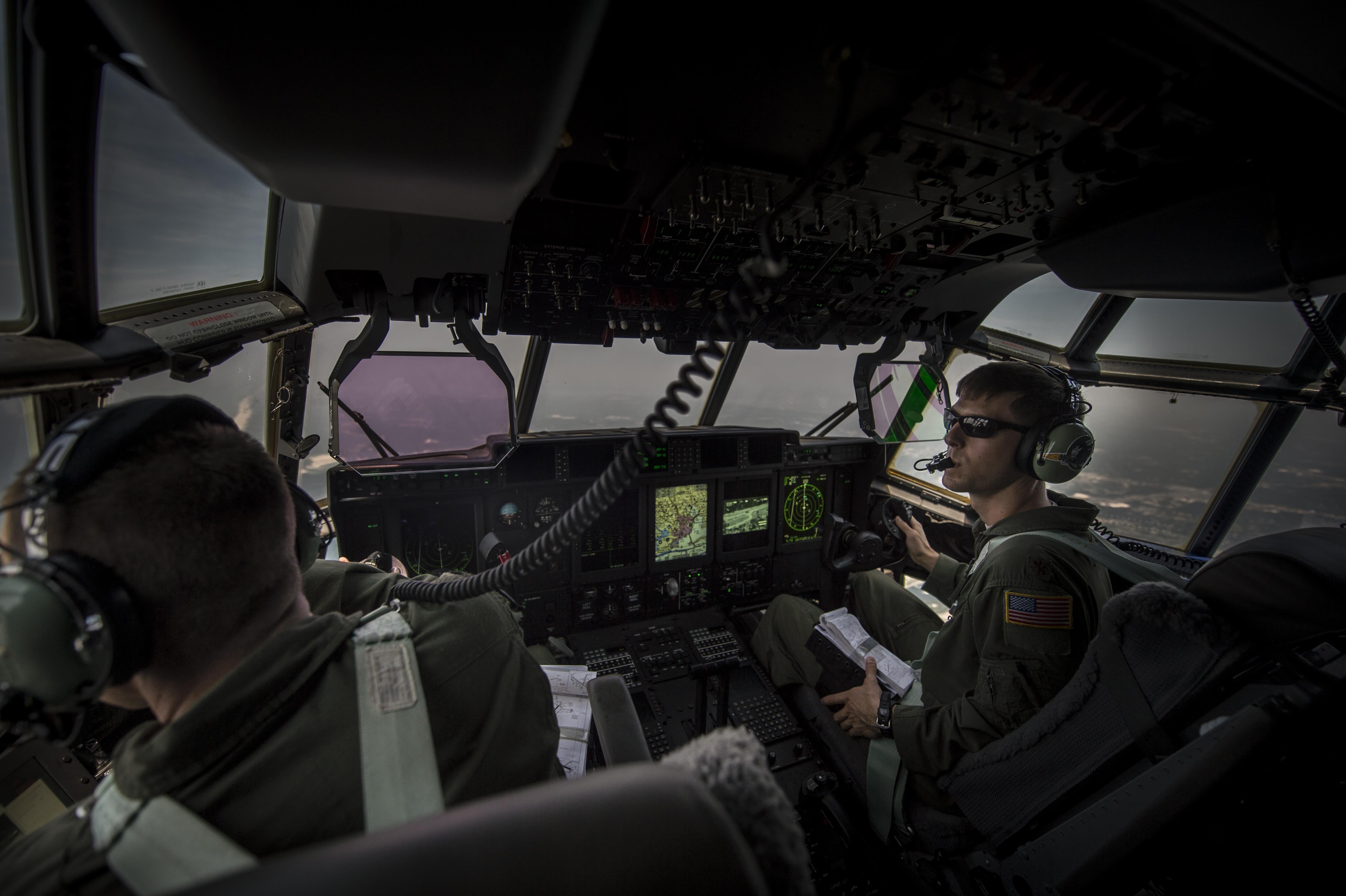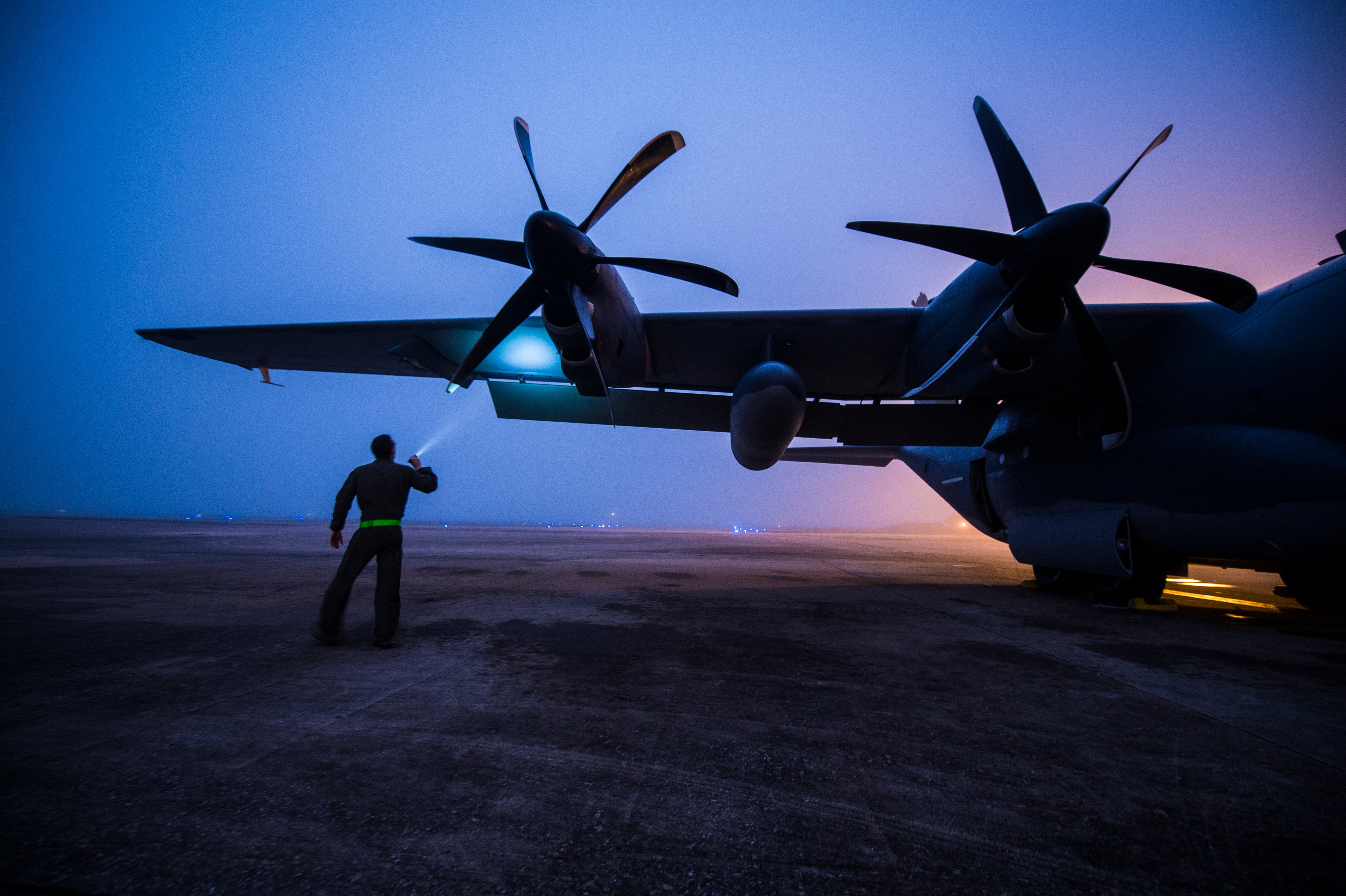HURLBURT FIELD, FLORIDA – In the not-too-distant future, when ground troops call for close-air support, the ‘Ghostrider’ and its deadly arsenal could come to their rescue. The AC-130J Ghostrider is set to be the most heavily-armed gunship in history, bristling with 30mm and 105mm cannons, AGM-176A Griffin missiles, and the ability to carry Hellfire missiles and GBU-39 Small Diameter Bombs. But that’s not all. Some day in the future, the Ghostrider could even be equipped with a high-energy laser. That’s right. Lasers. When it hits the battlefield in a few short years, the Ghostrider will be the most heavily armed gunship in history – a badass plane providing close-air support to U.S. troops on the ground and delivering withering firepower that will send enemies running for the hills.
Aircraft such as the F-35 and A-10 may be the focus of headlines, arguments on Capitol Hill between brass and lawmakers, and viral videos pulsing with hard rock. But despite drawing a fraction of the attention, the AC-130 and all its variants have been workhorses of the past 15 years of war.
They rained down fire on the Taliban and al-Qaida during the early days of the Afghanistan war, and fought in many more battles there over the years. They supported ground troops during the invasion of Iraq in 2003, as well as in subsequent clashes, such as the battles of Fallujah. They conducted raids on Libyan dictator Moammar Qaddafi's forces during the civil war there in 2011. And as the military's focus gradually turned to the Islamic State militant group, the AC-130's guns were trained on ISIS fighters, vehicles and oil trucks in places such as Raqqa, Syria.
Since it first flew to war during Vietnam, the AC-130 has destroyed more than 10,000 trucks, the Air Force says. The AC-130J is the fourth generation of this model, and will eventually replace the aging U and W variants – and it's a virtual certainty that it will be loitering above the battlefield, wherever Americans are fighting, for decades to come.
The AC-130W Stinger II has a 30mm cannon, precision-guided munitions, and the GBU-39 Small Diameter Bomb. The AC-130U Spooky has 25mm, 40mm and 105mm guns. And the now-retired AC-130H Spectre had 20mm, 40mm and 105mm cannons. But until now, no gunship has had this combination of multiple high-powered cannons and precision-guided munitions.
On Sept. 6, an AC-130J Ghostrider lifted off from a runway at Hurlburt Field, Florida, and flew northeast to the range at nearby Eglin Air Force Base. Sitting on the range was an old, lone tank used for target practice. The crew of the Ghostrider trained its newly added 105mm cannon – basically a Howitzer mounted in the plane's belly – on the tank and opened fire, striking the tank several times.
The test was a success, the Air Force said, and a major milestone on the path to the AC-130J achieving initial operating capability, which is expected to come in the fourth quarter of fiscal 2017.
'A bomb truck with guns'
The Ghostrider is a Lockheed C-130J that's been heavily modified until it practically bristles with weaponry – so much so that Lt. Gen. Bradley Heithold, former head of Air Force Special Operations Command – famously called it "a bomb truck with guns" and "the ultimate battle plane" in 2015. Walking through the cargo bay of the 130J, the sheer amount of firepower on display quickly becomes apparent. After leaving the cockpit, one first encounters the block 10 30mm cannon – an automatic weapon that can fire up to 200 rounds per minute, each roughly the size of a Coca-Cola bottle, out of the left side of the plane.
"Each round blows up with the equivalent [blast] of a hand grenade," said Maj. Jarrod Beers, a weapons system officer on the AC-130J, on Sept. 7. "And there are plenty of them on the aircraft."
The 30mm brings a lot of flexibility to the Ghostrider's crew. Not only is it trainable, making it easier to aim at a target without having to reorient the entire plane, but its ammunition feeds in from two different chains. This can give the Ghostrider plenty more of one kind of ammo to shoot – but it can also allow airmen to quickly switch to a second kind of ammunition if they need to take out a different threat.
"It's a very capable, and very awesome weapons system," Beers said.
Toward the aft end of the plane, also aiming left, is the block 20 105mm cannon. The Ghostrider originally wasn't meant to have the 105mm, which was also mounted on the older AC-130U Spooky model, but Heithold insisted on adding it, telling reporters last year, "I want two guns."
The 105mm cannon shoots rounds that weigh 50 pounds apiece – with more than 32 pounds of explosive – and are about 2 ½ to 3 feet long, Beers said. To illustrate what kind of a boom it delivers, some of the Army's howitzers also fire 105mm shells. "It's literally an artillery weapon that we decided to shoot down from the sky, instead of up from the ground," Beers said.

AC-130J Ghostrider
Photo Credit: Air Force
But that massive boom also recoils the gun back 49 inches, with 14,000 pounds of force – easily enough to instantly kill an unfortunate crew member caught behind it. For that reason, a safety cage was built around the 105mm cannon to keep airmen away from danger.
Beers said the airframe of the AC-130J is stronger than it normally would be so that it can handle the fatiguing effect of such massive recoil. But, he said, the crew is careful not to shoot both the 30mm and 105mm at the same time, since that would double up on the stress and recoil.
But the crew feels the recoil nonetheless. For example, an AC-130U pilot with the 4th Special Operations Squadron, who asked that his name not be used, said sustained bursts of his plane's 25mm Gatling gun – which can fire 1,800 rounds per minute – actually pushes the nose to the right.
"As pilots, we need to counteract that force to make sure the gun stays where it needs to shoot," the Spooky pilot said. "You can definitely feel the 105 when it shoots. It's a huge recoil from the 105, but definitely the 25mm is the most significant recoil that we feel up front."
The AC-130J will carry 80 105mm rounds, and can fire more than 10 rounds a minute, Beers said, and the plane's crew can also use the controls to aim it at targets.
AFSOC spokeswoman Erica Vega said in an email that the successful Sept. 6 test of the 105mm was to make sure systems worked together so the gun can safely fire.
"Future tests will look more into actual vs. expected accuracy and other system performance standards," Vega said. "We should learn a great deal more from those tests, and that will contribute to the aircraft's overall effectiveness, and in turn, better prepare it for IOC."
Zoom stick and boom stick Between the 30mm and the 105mm cannons is the MOP, or Mission Operator Pallet – two stations, one for WSOs like Beers and one for an enlisted sensor operator, each with multiple video screens and instruments controlling the array of cameras and sensors that help the crew target, and another control used to fire weapons. It uses some instruments borrowed from the F-35, which Beers said helps save money.
"This is the zoom stick, and this is the boom stick," Beers said, gesturing first to the control on the left and then to the control on the right.
Beers demonstrated how he uses the "zoom stick" to turn the plane's cameras 360 degrees and toggle between a standard view and infrared, switch the infrared's polarity, and tweak the image for better resolution. He pointed it toward a light pole far off in the distance on the tarmac and zoomed in – and zoomed, and zoomed, and zoomed again, until a tiny red bulb on top of the light pole filled the screen, pixelated and shimmering beneath the thermal heat radiating up.
"That's as good as it's going to get right now because of the thermals," Beers said, "That doesn't look good on the ground, but in the air, it's a pretty darn good picture."
From the MOP, crew members must absorb a massive amount of information for their situational awareness – where friendly troops and aircraft are, where enemies and their vehicles are, where civilians are – using radio communications, emails, targeting data, and video beamed in from other sources, such as command headquarters.
"It's a pretty formidable arsenal, and we haven't even gotten to the Griffins yet," Beers said.
The AGM-176A Griffin missiles are the centerpiece of the Ghostrider's precision-strike package – and part of what makes it truly stand above its predecessors. The plane carries 10 Griffins, which are essentially half-scale Hellfire missiles that are laser-guided, with a fragmentation warhead and a GPS backup to ensure it lands on target. Each Griffin stands nose-up in a roughly 4-foot-tall tube mounted in its tail. When it's time to fire, the Griffin is electrically launched out of the back of the plane, pops out its fins, and orients itself into the windstream. When it's far enough away, its rocket motor fires and it "goes screaming off past the plane," Beers said.
"It's nuts, it's the coolest thing ever," Beers said.

Master Sgt. James Knight, left, an aerial gunner with the 18th Flight Test Squadron, performs a pre-flight inspection at Eglin Air Force Base, Florida, July 29, 2015.
Photo Credit: SrA Christopher Callaway/Air Force
But those missiles – being precision-guided munitions – are much more expensive than the 30mm or 105mm shells, Beers said. So they're typically reserved for the highest-priority targets that must be hit with the greatest accuracy. The AC-130J also can carry Hellfire missiles and GBU-39 Small Diameter Bombs.
All the various weapons on board allow the crew to gradually escalate the amount of force used to meet the threat. "So, [we] take out the smaller targets with the 30, then escalate up to the 105, and even the 250-pound glide munitions [GBU-39 bombs] as we go up," Beers said. Frickin' lasers
And it could get even cooler. At the Air Force Association's conference last September, Heithold declared, "I want a high-energy laser on an AC-130J gunship by the close of this decade."
"This isn't Star Wars stuff, folks," he continued. "The technology is ripe for doing this. I've got the space, I've got the weight, and I've got the power."
Heithold floated the idea of first using a laser -- possibly mounted in place of the 105mm gun – in a defensive capacity, to take down an enemy missile fired at the AC-130J. But eventually, Heithold said, he envisioned using it for offense, to disable enemy aircraft or other vehicles. Such a laser could have come in handy during the 1989 capture of Panamanian dictator Manuel Noriega, he said. During that operation, four Navy SEALs died in the process of destroying his boat and airplane to keep him from escaping.
"Wouldn't it have been nice had we had a high-energy laser on an AC-130 that would have simply zapped some point on that airplane?" Heithold said at AFA. "Disable the aircraft and nobody knows it happened until they go to use it, because nobody heard anything and nobody saw anything. You haven't spooked anybody, you've simply disabled the aircraft."

Maj. Brian Pesta, right, 1st Special Operations Group Detachment 2 pilot, and Maj. Jason Fox, 18th Flight Test Squadron pilot, look out the left window during the delivery flight of Air Force Special Operations Command's first AC-130J Ghostrider.
Photo Credit: Senior Airman Christopher Callaway/Air Force
Beers agreed that a silent laser would be a great weapon to have at his disposal.
The laser would "give us an advantage, and be able to just take out a truck from miles away, without nobody knowing," Beers said. "I'm looking forward to trying them out."
Heithold has also suggested buttressing the plane's capabilities with small drones to help it fight in heavy cloud cover. When targets are under thick clouds, he said, the 130J can't identify and hit them. But if the plane could launch a drone from its rear tubes, instead of the usual missile, Heithold said it could fly below the clouds and target the enemy.
Beers also said a drone could help in mountainous terrain, or in areas with heavy fire that would otherwise endanger the 130J.
"So now I'm not risking myself and my crew in order to go in and prosecute that target," he said. It would "give us an advantage over previous generation gunships at that point."
A lighter aircraft -- but at what cost? But there's more than just its weaponry that makes the Ghostrider remarkable. It's lighter, faster and more efficient, Beers said, and burns 25 to 30 percent less gas than legacy aircraft. It flies at a top speed of about 362 knots, or 416 miles per hour – well above the roughly 300 mph top speed of the AC-130U. The AC-130J can fly a maximum range of 3,000 miles and up to 28,000 feet in the air – about twice as far, and roughly 3,000 feet higher than the AC-130U.
A big part of what makes the Ghostrider more efficient is its six-bladed propellers, which provide more thrust and allow it to carry more ammunition or fuel. But the increased efficiency may come at a price, however. The AC-130J was dinged by the Pentagon's weapons testers, the Office of the Director, Operational Test and Evaluation, in a 2013 report for having lighter armor than its predecessor, the AC-130U. The report said the AC-130U's armor protects aircrew stations, personnel, ammunition and critical systems against a 37mm high-explosive incendiary round at a range of 10,000 feet, or about 3,000 meters.

Staff Sgt. Derek Watson, a special missions aviator with the 1st Special Operations Group Detachment 2, inspects a wing of an AC-130J Ghostrider during a pre-flight inspection at Hurlburt Field, Fla., Feb. 2, 2016.
Photo Credit: Senior Airman Christopher Callaway/Air Force
The AC-130J's armor, on the other hand, protects primary crewmember positions and oxygen supplies against a 7.62mm ball projectile at 100 meters, the report said. The armor on the AC-130J also doesn't cover the Mission Operator Pallet, which weapons testers said should be considered a primary crewmember position and protected.
When asked about the tester's armor concerns, Vega said in an email, "The final AC-130J will have adequate defensive systems [and] features to fulfill its designed role. As the aircraft approaches IOC, all systems will be finalized and adjustments made." In another email, AFSOC spokesman Michael Raynor said, "Lt. Gen. [Brad] Webb [current AFSOC commander] has gone on record saying there are no trade-offs being made with security of the crews."
In the J's cockpit, a series of multi-function electronic displays has replaced the old analog dials that used to clutter up the view of pilots and navigators. So, instead of having, say, a physical weather radar in front of a navigator's face, whether or not he needs it, crewmembers can call up only the most pertinent digital instruments such as radar and collision avoidance systems or hide unwanted instruments with the ease of flipping through an iPad app.
"Looking at this is crazy," said Beers, who previously served as a navigator on older planes like the C130E/H. "This is a totally spaceship type of thing up here. The plane has a lot more 'go,' it's quieter, it's more comfortable inside, the air conditioning is better, which allows us to be better for the guys" on the ground.
And Beers is champing at the bit to put this plane into action to protect his fellow service members.
“The biggest thing for me is to make sure the guys on the ground get home OK,” he said. “That’s really what makes it worth it at the end of the day.”
Stephen Losey is the air warfare reporter for Defense News. He previously covered leadership and personnel issues at Air Force Times, and the Pentagon, special operations and air warfare at Military.com. He has traveled to the Middle East to cover U.S. Air Force operations.





